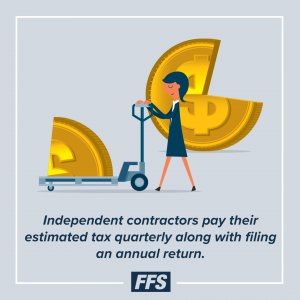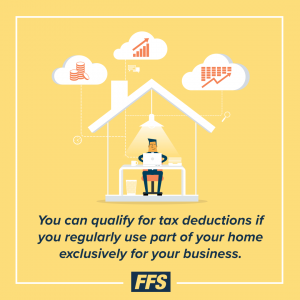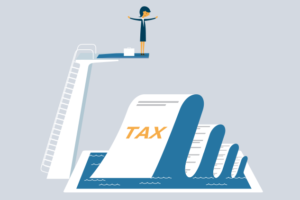Filing taxes for independent contractors can be a very different process than filing for employees. Contractors must pay a self-employment tax as well as income tax. Here’s what you need to know to file as an independent contractor:
Follow the Guidelines for Filing as Self-Employed
For IRS Purposes, independent contractors file as Self-Employed, which makes their earnings subject to Self-Employment Tax. Contractors are typically required to pay their estimated tax quarterly along with filing an annual return.
Self-Employment (SE) tax is basically the contractor’s way of paying the Social Security and Medicare taxes that would be withheld from the pay of most workers by their employers. The term self-employment tax does not include any other tax such as standard income tax.
Determine your SE tax and income tax by figuring the net profit from your business first — subtract your business expenses from your income. If this net profit from self-employment was $400 or more, you have to file an annual return; if it was less than $400, you only have to file an income tax return if you meet another other filing requirement listed in the these IRS instructions (use Charts A, B, and C on pages 8–11).
 Making Payments and Filing Your Return
Making Payments and Filing Your Return
To make quarterly payments, use the estimated tax worksheet found on IRS Form 1040-ES (be sure to have your prior year’s annual tax return handy, as you’ll need it to fill out this form). This worksheet has step-by-step instructions to determine and pay your quarterly payments, including the amount due on each date and a space to keep track of each payment’s date and confirmation number (check, debit or credit card). See the Estimated Taxes page and Self-Employment Tax page for more information.
Your annual return is then used to report the total income or loss from your business, along with the SE and income taxes you paid during the year. When it comes time to file your annual return on July 15, use Schedule C to report your income, and Schedule SE to report your Social Security and Medicare taxes. Follow these instructions for the Schedule C and instructions for the Schedule SE for step-by-step guides to filling out these forms from the IRS.
Take Advantage of Deductions
As an independent contractor, the IRS allows you to deduct many of your business expenses — costs for computers, printers and other technology used at work, plus the cost of phone calls, supplies, and travel as long as all expenses were work-related. Deductions also apply to the costs of renting an office or running a home office. Additionally, half of the Social Security and Medicare taxes you pay are deductible.
You can apply home office deductions if you regularly use part of your home exclusively for your business. You have two options for deducting if you qualify: a simplified option that deducts $5 for every square foot of your house that qualifies as part of your business, up to $1,500; or a standard method based on actual expenses, adding up portions of your rent, utilities, mortgage interest, property taxes and homeowners insurance.
The details of these deductions are too extensive to summarize in all forms here. More information about tax-deductible business expenses can be found at this IRS Form, the home-office deduction factsheet, Form 8829 (Expenses for Business Use of Your Home), the Self-Employed Individuals Tax Center and the IRS Tax Guide for Small Business. Further reading can also be found at this Kiplinger’s guide to the Most Overlooked Tax Breaks for the Self-Employed.
 COVID-19 Updates to Taxes in 2020
COVID-19 Updates to Taxes in 2020
It would be an understatement to say that many self-employed workers have been hit hard by the COVID-19 outbreak. Luckily, relief provisions have been put into place by the IRS in the form of tax credits for sick and family leave. For example, if you were forced to take sick leave for either your health or for the care of a family member, you may be eligible for a refundable tax credit for up to ten days of sick pay. Additionally, there is a tax credit for qualified family leave if your child was unable to attend school or daycare due to closed facilities. These credits are refundable, so if you are claiming a credit with an amount more than the taxes you owe, you will receive a refund for the difference. For detail on these credits, visit this IRS Overview Page.
The IRS will require proof that you qualify to claim each of these credits as well, so be sure to save anything you receive related to COVID-19 testing, your family’s medical care, and closures of schools and daycares. Note that these credits will apply for your 2020 tax return that you file in 2021, not for the tax return you will be filing for 2019, which is due by July 15, 2020.
Be Diligent Before You File
Remember to use the IRS’ resources as much as you can to ensure that you’re filing taxes as an independent contractor properly. Do not hesitate to consult a tax professional for any questions and concerns you have in the process. Take advantage of these credits and deductions to ensure you have all the funds you need to take care of yourself and your family and ensure financial security and peace of mind.
Read our other articles in the Focus on YOUR Money series to get tips on prioritizing debt in a crisis, saving more money with budgeting, and how to improve your credit score.
FFS Agents – share this post with your networks using our resources in the ABO.




